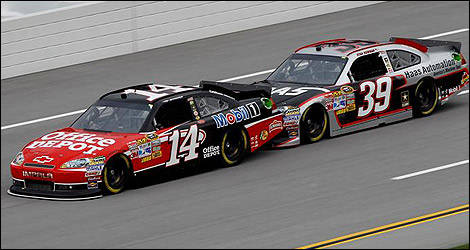NASCAR officials announced a rules change aimed at breaking up the two-car drafts seen at the restrictor plate races since Talladega last year.
The rules change consists of a larger restrictor plate opening, by 1/64th of inch, which will result in seven to ten more horsepower. And the pressure-relief valve on the cars' engine cooling system will be recalibrated to reduce the pressure by approximately eight pounds per square inch from last April's race at Talladega.
“After the last few superspeedway races, we’ve heard many drivers express their desire to open up the size of the restrictor plate some and we thought the time was right to do that,” said Robin Pemberton, NASCAR vice president, competition. “We anticipate these revisions in the rules package for Talladega will help continue to provide competitive and exciting racing for the fans.”
That’s great news for Dale Earnhardt Jr. who once was almost unbeatable at Talladega. ”I hope it makes the cars go faster,” he said” I want to go faster at Talladega and Daytona,” he added.
While the two-car drafts produced lap speeds in excess of 200mph before some other rules changes at Daytona this year, when they qualified, in single car style, it was only at speeds of 185mph. “Hopefully, with the changes, we can break away from each other,” added Earnhardt. “We can drive up through the pack into the lead – alone - without having a guy shoving you through up there.”
Ironically another Hendrick Motorsports crew chief says the racing won’t change very much with the new rules.
“This is not going to stop the two-car draft,” said Lance McGrew, crew chief of the No. 5 GoDaddy.com Chevrolet. “You can’t unlearn something. It’s just going to slow the cars down. You’ll see the rear car will be further stepped out on the right-rear quarter panel of the guy in front of him so he gets more of his radiator in the airstream. Ultimately, it’s not going to take the two-by-two racing away.”
So how will it be done?
Kurt Romberg, chief aerodynamicist for Hendrick Motorsports, says timing will be critical for this strategy.
"I still think running aligned perfectly nose-to-tail is going to be the fastest way around the track," Kurt Romberg said. "You’re just going to have to time it a lot better. Previously you could run that way for a number of laps and ride the race out till the end, look for a good drafting partner and once you find them, you can go to the end and probably do pretty well.
This is going to be a little more challenging to the drivers and crew chiefs because you can’t spend so much time behind another car without staggering your position on its bumper. If you want to get the maximum speed, you can stay in line for maybe a lap or two, maybe three before you’re going to have to swap positions. As a result, that could mix up the racing a lot more."
The rules change consists of a larger restrictor plate opening, by 1/64th of inch, which will result in seven to ten more horsepower. And the pressure-relief valve on the cars' engine cooling system will be recalibrated to reduce the pressure by approximately eight pounds per square inch from last April's race at Talladega.
“After the last few superspeedway races, we’ve heard many drivers express their desire to open up the size of the restrictor plate some and we thought the time was right to do that,” said Robin Pemberton, NASCAR vice president, competition. “We anticipate these revisions in the rules package for Talladega will help continue to provide competitive and exciting racing for the fans.”
That’s great news for Dale Earnhardt Jr. who once was almost unbeatable at Talladega. ”I hope it makes the cars go faster,” he said” I want to go faster at Talladega and Daytona,” he added.
 |
| Two-car draft with Tony Stewart and Ryan Newman. (Photo: nascar.com) |
While the two-car drafts produced lap speeds in excess of 200mph before some other rules changes at Daytona this year, when they qualified, in single car style, it was only at speeds of 185mph. “Hopefully, with the changes, we can break away from each other,” added Earnhardt. “We can drive up through the pack into the lead – alone - without having a guy shoving you through up there.”
Ironically another Hendrick Motorsports crew chief says the racing won’t change very much with the new rules.
“This is not going to stop the two-car draft,” said Lance McGrew, crew chief of the No. 5 GoDaddy.com Chevrolet. “You can’t unlearn something. It’s just going to slow the cars down. You’ll see the rear car will be further stepped out on the right-rear quarter panel of the guy in front of him so he gets more of his radiator in the airstream. Ultimately, it’s not going to take the two-by-two racing away.”
So how will it be done?
Kurt Romberg, chief aerodynamicist for Hendrick Motorsports, says timing will be critical for this strategy.
"I still think running aligned perfectly nose-to-tail is going to be the fastest way around the track," Kurt Romberg said. "You’re just going to have to time it a lot better. Previously you could run that way for a number of laps and ride the race out till the end, look for a good drafting partner and once you find them, you can go to the end and probably do pretty well.
This is going to be a little more challenging to the drivers and crew chiefs because you can’t spend so much time behind another car without staggering your position on its bumper. If you want to get the maximum speed, you can stay in line for maybe a lap or two, maybe three before you’re going to have to swap positions. As a result, that could mix up the racing a lot more."


